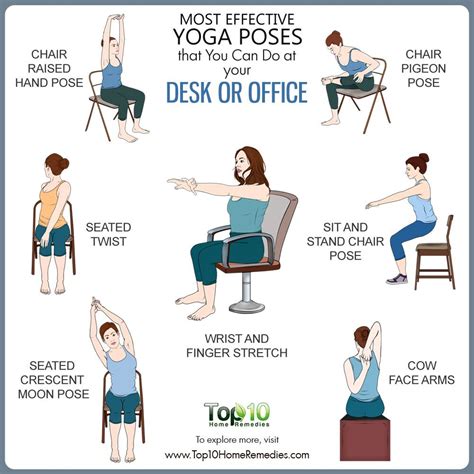Effective Yoga at Work: Quick Desk Poses for Productivity and Wellness
In today’s fast-paced work environment, spending long hours seated at a desk has become the norm. While this sedentary lifestyle can take a toll on physical and mental health, practicing yoga at work is a simple yet powerful solution to mitigate these negative effects. Incorporating quick desk poses can improve posture, reduce stress, and boost overall well-being. This article delves into the key concepts, benefits, and practical applications of yoga at work, with a focus on easy-to-do desk poses that anyone can implement throughout the workday.
Key Concepts of Yoga at Work
- Mind-Body Connection: Yoga promotes awareness of the body and breath, helping reduce the mental and physical strain caused by prolonged sitting.
- Posture Correction: Desk poses focus on opening the chest, stretching the spine, and improving alignment, counteracting poor posture from slouching or hunching.
- Stress Reduction: Breathing exercises (pranayama) incorporated into desk yoga help lower stress hormones, inducing a sense of calm and relaxation.
- Flexibility & Mobility: Simple stretches can enhance joint mobility and muscle flexibility, preventing stiffness from sitting too long.
- Energy Boost: Yoga increases circulation and energizes the body, improving concentration and productivity.
Historical Context of Yoga Integration in the Workplace
The integration of yoga in non-traditional settings like the workplace is not new. Yoga has long been recognized for its therapeutic effects in ancient Indian traditions, but it wasn’t until the late 20th century that Western companies began exploring it as part of wellness programs. Early adopters, such as tech companies in Silicon Valley, experimented with on-site yoga and mindfulness classes to help employees manage stress and increase productivity. The success of these programs led to a growing trend of incorporating yoga into daily routines, with desk yoga emerging as an efficient way to fit mindfulness and movement into a busy workday.
Current State of Desk Yoga: Trends and Benefits
Today, desk yoga is gaining popularity in workplaces worldwide. Employers are increasingly recognizing the importance of employee well-being, and yoga is an accessible, low-cost method for improving health and productivity. Research shows that just a few minutes of stretching and mindful breathing throughout the day can have significant physical and mental health benefits. Specifically, desk yoga helps alleviate common issues such as back pain, neck stiffness, and mental fatigue. Below are some of the current trends:
- Virtual Yoga Classes: Remote work has sparked a surge in virtual desk yoga sessions, allowing employees to participate from anywhere.
- Short Yoga Breaks: Many companies encourage employees to take short yoga breaks, as little as 5-10 minutes, to prevent burnout and enhance focus.
- Posture-Corrective Tools: Desk yoga is often paired with posture-correcting equipment like ergonomic chairs and standing desks to optimize comfort.
- Breathwork Emphasis: There’s a growing emphasis on pranayama (breathwork), which can be done discreetly at the desk and helps to calm the nervous system.
Practical Applications: Desk Yoga Poses
These desk yoga poses are designed to be performed without leaving your chair, making them easy to incorporate into a busy workday. Aim to practice a few of these poses multiple times throughout the day to break up long periods of sitting.
| Pose Name | Description | Benefits |
|---|---|---|
| Seated Forward Bend (Paschimottanasana) | While seated, extend your arms toward your feet and lower your torso toward your thighs. Hold for 30 seconds. | Stretches the lower back and hamstrings, improves spinal flexibility. |
| Chair Twist (Ardha Matsyendrasana) | Place your right hand on the back of your chair and twist your torso to the right. Repeat on the left side. | Relieves tension in the spine and promotes better posture. |
| Seated Cat-Cow Stretch (Marjaryasana-Bitilasana) | Alternate between arching your back and rounding it while seated, syncing with your breath. | Increases spinal flexibility and reduces stiffness in the back and shoulders. |
| Seated Shoulder Shrugs | Raise both shoulders towards your ears and release them downward, synchronizing with deep breaths. | Releases tension from the neck and shoulders. |
| Wrist and Finger Stretches | Extend your arms in front of you, spread your fingers wide, and rotate your wrists in both directions. | Prevents strain from typing and improves circulation to the hands. |
Case Studies: Companies Benefiting from Desk Yoga
Several organizations have successfully integrated desk yoga into their wellness programs, showing measurable improvements in employee satisfaction, health, and productivity. For example:
- Google: Employees participate in “mindful stretching” sessions during breaks, which has led to enhanced focus and reduced stress.
- Salesforce: Incorporating virtual yoga sessions into daily routines during remote work periods has helped employees feel more connected and energized.
- WeWork: Offers desk yoga workshops that include breathwork and stretches, contributing to an inclusive wellness culture in shared workspaces.
Stakeholder Analysis: Who Benefits from Yoga at Work?
- Employees: The primary beneficiaries, experiencing better physical health, mental clarity, and reduced workplace stress.
- Employers: Enhanced productivity, fewer sick days, and improved employee morale are key advantages for businesses.
- Health Providers: Encouraging yoga can reduce long-term health issues related to sedentary work environments, lessening the burden on healthcare systems.
Implementation Guidelines for Desk Yoga Programs
- Start Small: Introduce short, 5-10 minute yoga breaks to the workday and encourage regular participation.
- Provide Resources: Offer access to virtual classes, yoga tutorials, or downloadable guides for employees.
- Create a Culture: Encourage management to participate and normalize yoga as a part of the company’s wellness initiatives.
- Monitor Progress: Track employee participation and solicit feedback to refine the program based on their needs.
Ethical Considerations in Workplace Yoga Programs
As with any workplace wellness initiative, desk yoga programs must be inclusive and mindful of employees’ varying physical abilities and preferences. It’s important to ensure that participation is voluntary, and accommodations should be made for employees who may have physical limitations. Furthermore, companies should provide alternative wellness options for those who may not be interested in yoga, ensuring a diverse range of options to support holistic health.
Limitations and Future Research on Desk Yoga
While desk yoga has shown promising results in improving workplace well-being, more research is needed to quantify its long-term effects on productivity and employee health outcomes. One limitation is that some employees may find it difficult to consistently practice yoga during the workday, especially in high-pressure environments. Future research could explore the effectiveness of different yoga styles or mindfulness practices and their impact on specific industries. Additionally, more studies are needed to assess the role of desk yoga in remote work settings, where employees may have varying levels of ergonomic support.
Expert Commentary
As companies continue to prioritize employee well-being, desk yoga stands out as an accessible, cost-effective solution that can be seamlessly integrated into daily routines. Experts agree that even short yoga breaks can lead to substantial benefits, both for physical health and mental clarity. In particular, companies with high-demand roles should consider implementing desk yoga to help employees stay focused, reduce stress, and maintain overall wellness. As more businesses adapt to hybrid work models, desk yoga offers a practical way to support employees, regardless of where they work.








